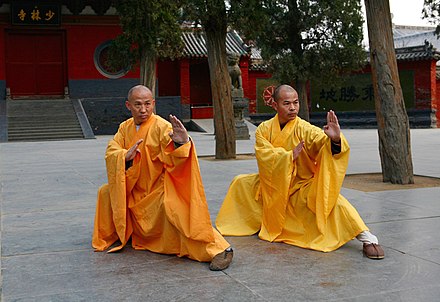Martial arts
Martial arts
 Martial arts have been around for millenia, and were historically (before gunpowder-based weapons) an important tool of combat, together with weapons like swords, sticks or spears; and such weapons are still an integral part of some martial arts. Today, martial arts techniques are used for self-defense, unarmed combat for the military, police and security guards. On the other hand martial arts are practiced as spectator sports, as a form of moving meditation, and as performance art.
Martial arts have been around for millenia, and were historically (before gunpowder-based weapons) an important tool of combat, together with weapons like swords, sticks or spears; and such weapons are still an integral part of some martial arts. Today, martial arts techniques are used for self-defense, unarmed combat for the military, police and security guards. On the other hand martial arts are practiced as spectator sports, as a form of moving meditation, and as performance art.
Understand
Learn
The most popular and famous martial arts are taught around the world, and in world cities you can also learn some more unusual ones. Still, there are many reasons for learning and practicing a particular art in its native region.
As martial arts are an integral part of the history and culture of the place they come from, it's most certainly going to be a different experience than, say, at the local gym in your home town. If you've already attained some skill in the art, you may get to train and learn with famous masters or in a famous ring or dojo. On the other hand, if you are a beginner, there may be some basic classes available.
Learning martial arts requires a lot of patience, discipline, training and hard work. Be prepared to spend many years in training if you want to be able to use martial arts competently in an actual fight.
See
The places where martial arts come from are also the best places to see them in the form of performances or as a match or game. In addition the places where the arts were born and developed can also be worth seeing, especially if you're practicing the particular art yourself.
Many martial arts including wrestling, boxing, judo, karate, taekwondo and fencing are also Olympic sports.
Destinations
Destination in alphabetical order.

- Brazil. Brazil is known for two martial arts with roots in different parts of the world.
Africans transported to Brazil as slaves developed capoeira out of Angolan traditional fighting styles. Even banned back in the day, today it's an important part of Brazilian culture, one of the more spectacular martial arts, doubles as a dance and is often performed to music. Capoeira is visible on the streets and beaches especially in coastal cities and there are also capoeira schools here.
Later Japanese immigrants brought martial arts with them to the country, and Carlos Gracie and other students of judo and jujitsu in Belém started developing their own variant of jujitsu, focusing more on ground techniques; this is today known as Brazilian jujitsu or BJJ. CBJJ regulating the sport lists several competitions and courses around the country, mostly in bigger cities. Also of note is that BJJ played a major role in the modern development of MMA. Almost all serious MMA fighters include BJJ in their training. 2019-08-16

Chinese martial arts are collectively known as wushu (武术 wǔshù). There are numerous wushu tournaments both in China and internationally that you can watch, with the Asian Games and World Wushu Championships being the premier tournaments in the sport. Wushu at tournaments is generally divided into two genres; taolu is the performance of choreographed martial arts routines, and sanda or sanshou is actual combat. Chinese martial arts can be broadly divided into northern and southern styles, with northern styles generally emphasizing powerful strikes with fully extended limbs, and southern styles generally emphasizing fast strikes close to the body. - Shaolin Temple (少林寺), 34.5084°, 112.9354°. An important Zen Buddhist temple, Shaolin-style kung fu was according to legend invented here by the Indian monk Bodhidharma (达摩 dámó) in the 7th century CE to allow the monks to defend themselves against bandits. This martial art has influenced many other systems both in China and elsewhere in Asia. There are courses for both beginners and more advanced practitioners. 2019-08-16 - Wudang Mountains (武当山), 32.400833°, 111.003889°. Considered by many to be the most sacred Taoist site in China, it has also long been associated with various styles of martial arts including tai chi (太极拳 tàijíquán). Often considered to be the main rival (albeit a friendly one) to Shaolin Temple in the world of martial arts. 2019-08-17 - Quanzhou (泉州), 24.8744°, 118.6757°. Home to the Southern Shaolin style of Chinese martial arts, said to be founded by monks from the original Shaolin Temple in Henan who fled south to Fujian to escape war, and also said to be the origin of all southern Chinese martial arts. 2020-03-20 - Foshan (佛山), 23.0214°, 113.1216°. Birthplace of famous martial artists Wong Fei-hung of the Hung Ga school, and Ip Man (Bruce Lee's master) of the Wing Chun school, and regarded to be the martial arts capital of Guangdong. 2020-03-20

-
Europe. As the land of knights and constant feudal warfare in the medieval era, Europe was historically home to various styles of martial arts. These are today collectively known as historical European martial arts (HEMA). Though many of these died out with the advent of firearms, there is today a thriving community of medieval warfare enthusiasts that have revived some of them using medieval treatises. Besides Europe, thriving HEMA communities can also be found in the United States, Canada, Australia and New Zealand. Since the Middle Ages, fencing has been the sport of European gentlemen, commonly studied on the Grand Tour, and is also an Olympic sport. 2019-08-17
-
France. Paris and Marseille are the two cities associated with savate, a type of kickboxing developed in the early 19th century. Sailors in Marseille developed a "game" with kicks and open-hand slaps, Michel Casseaux opened the first savate studio in Paris, and his student Charles Lecour incorporated English boxing into it. As such there are no famous "shrines" to the sport, but a lot of places to train, learn and see matches around the country. Along with Italy, France was one of the most important countries in the development of modern Olympic fencing, with most fencing terminology and referee commands being in French to this day. 2019-08-16
-
Israel. Krav maga, the martial art Israel is known for, is different from the others in the list, as it is not a sport or art, but a modern self-defense system. There are plenty of krav maga schools around Israel where international students can learn from some of the best instructors in the world, and courses adapted to different kinds of students from children to transport workers and bodyguards to disabled persons. 2019-08-16
-
Japan, 36.67°, 139.42°. There are many martial arts in Japan. Karate can be learned in Okinawa, the birthplace of karate, or in mainland Japan. Many other famous martial arts originate from here including judo and aikido focusing on grappling and throws, jujutsu (and other styles ending in -jutsu, translating to technique) focusing on both empty-handed fight and weapons, and kendo focusing on stick fighting. See also Working and studying in Japan#Martial arts. The local style of professional wrestling, despite its predetermined nature, incorporates many elements from Japanese martial arts. 2019-08-16
- Kodokan (講道館), 35.707619°, 139.753402°. The headquarters of the worldwide judo community, where many judo masters are trained. Foreign judoka may apply to spar with other judoka at the Kodokan while visiting Tokyo. Judo was the first martial art to become an Olympic sport in 1964. 2019-08-17
- Okinawa. The system known as karate was developed in Okinawa in the Ryukyu Kingdom, but when the islands were annexed by Japan, it spread to the Japanese mainland, got its current name (karate means "empty hand" in Japanese) and is now one of the most famous Japanese martial arts. There are dojos where you can learn the original form of karate (different from the widespread modern version), places like graves of old masters, and a karate-themed bar in Naha. Karate was contested at the Olympics for the first time in 2021. 2019-08-16
-
- Indonesia, Malaysia, Brunei & Singapore. The area is known for a unique indigenous style of martial arts known as pencak silat in Indonesian, sometimes shortened to silat in Malay. There is also a beautiful stylized dance version called silat gayung which is well worth seeing if you have the chance. 2019-08-17
- Philippines. Philippines is the place to go to see and learn the stick- and sword-based martial art which is known by the names eskrima and kali. There are many training centers around Metro Manila, for example. 2019-08-18
- Thailand. Muay thai, or thai boxing, has roots in unarmed fighting techniques from the 18th century. Today it is one of the best known variants of kickboxing. There are muay thai gyms and stadia all over the country. 2019-08-16
.jpg/440px-KOCIS_Korea_Taekwondo_Namsan_12_(7628125294).jpg)
- South Korea
- Kukkiwon (국기원), 37.5019°, 127.0304°. Taekwondo, the most famous Korea martial art is rather modern. It was developed in the 1940s based on traditional Korean martial arts, karate and various Chinese styles. The headquarters of the sport, kukkiwon, is in Seoul, and it hosts the World Taekwondo Academy where taekwondo teachers and referees are educated. Also demonstrations and competitions are held on the premises. Taekwondo became the second martial art to become an Olympic sport in 2000. 2019-08-16
- United States of America
- Las Vegas, 36.16°, -115.14°. Described as one of the world's centers of fighting sport, there are many venues where you can see see matches in mixed martial arts (MMA), boxing or wrestling, including T-Mobile Arena, the MGM Grand, Thomas & Mack Center and Caesars Palace. Las Vegas is also the home of the main promoter of MMA, UFC. 2019-08-29
Talk
While martial arts courses are conducted in all languages, technical terms and referee commands are often in the language of the country of origin. For instance, judo and karate use many Japanese terms, taekwondo uses many Korean terms, and fencing uses many French terms. You do not need to be fluent in the respective language to practise the martial art, though you will have to familiarise yourself with the relevant terminology and commands, which will be taught to you in class.
Stay safe
Travel insurance policies often don't cover injuries caused by partaking in risky activities such as martial arts.